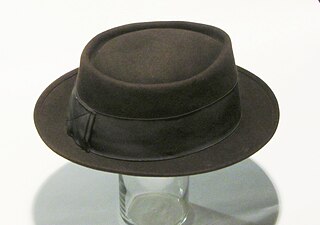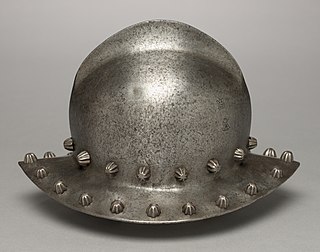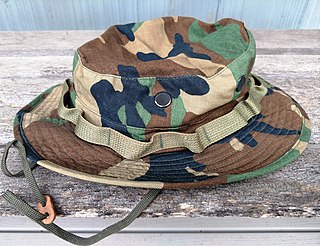
A hard hat is a type of helmet predominantly used in workplace environments such as industrial or construction sites to protect the head from injury due to falling objects, impact with other objects, debris, rain, and electric shock. Suspension bands inside the helmet spread the helmet's weight and the force of any impact over the top of the head. A suspension also provides space of approximately 30 mm between the helmet's shell and the wearer's head, so that if an object strikes the shell, the impact is less likely to be transmitted directly to the skull. Some helmet shells have a mid-line reinforcement ridge to improve impact resistance. The rock climbing helmet fulfills a very similar role in a different context and has a very similar design.

A baseball cap is a type of soft hat with a rounded crown and a stiff bill projecting in front.

A top hat is a tall, flat-crowned hat traditionally associated with formal wear in Western dress codes, meaning white tie, morning dress, or frock coat. Traditionally made of black silk or sometimes grey, the top hat emerged in Western fashion by the end of the 18th century. Although it declined by the time of the counterculture of the 1960s, it remains a formal fashion accessory. A collapsible variant of a top hat, developed in the 19th century, is known as an opera hat.

A hat is a head covering which is worn for various reasons, including protection against weather conditions, ceremonial reasons such as university graduation, religious reasons, safety, or as a fashion accessory. Hats which incorporate mechanical features, such as visors, spikes, flaps, braces or beer holders shade into the broader category of headgear.

A slouch hat is a wide-brimmed felt or cloth hat most commonly worn as part of a military uniform, often, although not always, with a chinstrap. It has been worn by military personnel from many different nations including Australia, Ireland, the United Kingdom, Canada, India, New Zealand, Southern Rhodesia, France, the United States, the Confederate States, Germany and many others. Australia and New Zealand have had various models of slouch hat as standard issue headwear since the late Victorian period.

A fedora is a hat with a soft brim and indented crown. It is typically creased lengthwise down the crown and "pinched" near the front on both sides. Fedoras can also be creased with teardrop crowns, diamond crowns, center dents, and others, and the positioning of pinches can vary. The typical crown height is 4.5 inches (11 cm). The term fedora was in use as early as 1891. Its popularity soared, and eventually it eclipsed the similar-looking homburg.

Bonnet has been used as the name for a wide variety of headgear for both sexes—more often female—from the Middle Ages to the present. As with "hat" and "cap", it is impossible to generalize as to the styles for which the word has been used, but there is for both sexes a tendency to use the word for styles in soft material and lacking a brim, or at least one all the way round, rather than just at the front. Yet the term has also been used, for example, for steel helmets. This was from Scotland, where the term has long been especially popular.

Stetson is an American brand of hat manufactured by the John B. Stetson Company. "Stetson" is also used as a generic trademark to refer to any campaign hat, particularly in Scouting.

In English, a sombrero is a type of wide-brimmed Mexican men's hat used to shield the face and eyes from the sun. It usually has a high, pointed crown; an extra-wide brim that is slightly upturned at the edge; and a chin strap to hold it in place.

A pork pie hat is one of several different styles of hat that have been worn since the mid-19th century. The pork pie hat gained further popularity in the 20th century, being worn by famous actors and musicians. This style of hat features a flat crown that resembles a traditional pork pie, thus earning its name.

The tricorne or tricorn is a style of hat that was popular during the 18th century, falling out of style by the early 1800s, though not called a "tricorne" until the mid-19th century. During the 18th century, hats of this general style were referred to as "cocked hats". At the peak of its popularity, the tricorne varied greatly in style and size, and was worn not only by the aristocracy, but also as common civilian dress, and as part of military and naval uniforms. Typically made from animal fiber, the more expensive being of beaver-hair felt and the less expensive of wool felt, the hat's most distinguishing characteristic was that three sides of the brim were turned up (cocked) and either pinned, laced, or buttoned in place to form a triangle around the crown. The style served two purposes: first, it allowed stylish gentlemen to show off the most current fashions of their wigs, and thus their social status; and secondly, the cocked hat, with its folded brim, was much smaller than other hats, and therefore could be more easily tucked under an arm when going inside a building, where social etiquette dictates that a gentleman should remove his hat. Tricornes with laced sides could have the laces loosened and the sides dropped down to provide better protection from the weather, sun, and rain.

The cowboy hat is a high-crowned, wide-brimmed hat best known as the defining piece of attire for the North American cowboy. Today it is worn by many people, and is particularly associated with ranch workers in the western and southern United States, western Canada and northern Mexico, with many country music, regional Mexican and Sertanejo music performers, and with participants in the North American rodeo circuit. It is recognized around the world as part of traditional Old West apparel.

A kettle hat, also known as a war hat, was a type of combat helmet made of iron or steel in the shape of a brimmed hat. There were many design variations, with the common element being a wide brim that afforded extra protection to the wearer. It gained its common English language name from its resemblance to a metal cooking pot. The kettle hat was common all over Medieval Europe, and was called Eisenhut in German and chapel de fer in French.

The Tyrolean hat, also Tyrolese hat, Bavarian hat or Alpine hat, is a type of headwear that originally came from the Tyrol in the Alps, in what is now part of Austria, Germany, Italy and Switzerland. It is an essential and distinctive element of the local folk costume, or tracht.

A boonie hat or booney hat is a type of wide-brim sun hat commonly used by military forces in hot tropical climates. Its design is similar to a bucket hat but with a stiffer brim.

The Boss of the Plains was a lightweight all-weather hat designed in 1865 by John B. Stetson for the demands of the American West. It was intended to be durable, waterproof and elegant. The term "Stetson" eventually became all-but-interchangeable with what later became known as the cowboy hat due to later style-designs based on how the rounded-crown would deform from regular use.

Headgear, headwear, or headdress is any element of clothing which is worn on one's head, including hats, helmets, turbans and many other types. Headgear is worn for many purposes, including protection against the elements, decoration, or for religious or cultural reasons, including social conventions.

A mushroom hat is a millinery style in which the brim of the hat tilts downwards, resembling the shape of a mushroom. It is a style that first emerged in the 1870s and 1880s, when it was usually made of straw. It became fashionable again from around 1907 to the late 1920s; these versions featured a distinctly downturned brim although the size and shape of the crown varied according to prevailing fashions.

The Salvation Army bonnet was the headcovering worn by female members of the Salvation Army. It was introduced in 1880 in the UK and was worn as headgear by most female officers in western countries. It began to be phased out from the late 1960s.
A wideawake hat is a broad brimmed felt "countryman's hat" with a low crown, similar to a slouch hat. A wideawake hat is most commonly seen in dark shades of cloth, such as dark brown or black felt. The brim is fairly wide, and is flat in front and back but with a moderate upturn on the left and right sides. The brim may be asymmetric from side to side, as seen in the Rembrandt portrait, or symmetrical, as seen in the Quaker Oats logo. If asymmetric, it is more similar to a slouch hat, which has one side pinned to the crown and the other side allowed to droop. The top is styled flatly, rather than in a bowler curve. A hatband at the base is common. The name may derive from a humorous pun – the hat "never had a nap, and never wants one".


















